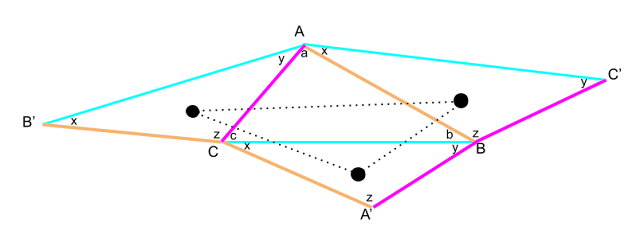I'm an avid follower of Mathologer videos and his latest on the Petr-Douglas-Neumann theorem was well up to his high standards. I hope to write another post on that video but today I am commenting on a special case - Napoleon's theorem - that many others have also discussed.
Seemingly there is no definite connection with Napoleon Bonaparte, or any other Napoleon, but the theorem does seem to have made its debut in the mathematical literature in the early part of the nineteenth century. So, given that Napoleon had many renowned mathematical friends and was keenly interested in science, it is possible that a connection may exist.
In its basic form Napoleon's theorem is:
Let ABC be any triangle. Then the centroids of the 3 equilateral triangles with bases AB, BC, CA erected on the outside of triangle ABC form an equilateral triangle.
There are several proofs and generalisations. The proof that I give below is similar to the one here but handles one of the known generalisations of the theorem.
First some terminology.
We shall deem two triangles to be similar if one can be transformed into the other by a translation, scaling factor, and rotation. In particular this means that the set of interior angles of one triangle is the same as the other and these angles occur in the same order around their triangle. The second condition is not always part of the definition of similarity.
If we think of our similar triangles as lying in the plane where every point is a complex number then we have the following necessary and sufficient condition that the triangle with vertices (z1, z2, z3) is similar to the triangle with vertices (w1, w2, w3):
This (elementary) result is proved
here which refers to G. H. Hardy's classic
textbook. It follows immediately from properties of determinants that triangle
z1z2z3 is similar to every triangle
pz1+qw1,pz2+qw2,pz3+qw3, with
p and
q not both zero. This extends to three (the case we shall use) or more similar triangles: if we have three similar triangles then any weighted sum of them will be a triangle similar to the summands.
Now we are ready to present the generalisation of Napoleon's theorem. We begin with an arbitrary triangle and erect, on each side, 3 similar triangles as shown below:
The diagram shows the three similar triangles in question as AC'B, CBA', B'AC. The angles and colours are intended to indicate the similarity correspondences. The three black dots are the centroids of the similar triangles.
So we have AC'B ~ CBA' ~ B'AC.
Now we take a weighted sum of these three triangles with weights 1/3, 1/3, 1/3. This gives a triangle with vertices (A+C+B')/3, (C'+B+A)/3, (B+A'+C)/3. From the discussion above this triangle is similar to the three original triangles. But these vertices are also the centroids of the original similar triangles.
I believe this proof is a lot more concise than most of the others and, of course, it proves something more general. One of the interesting aspects of the proof is that the technique of coordinatising the plane was not discovered until Descartes; so the proof could not have been discovered by the classical geometers.
In the case that the 3 similar triangles are equilateral this gives Napoleon's theorem. But different choices for the weights other than 1/3, 1/3, 1/3 give other interesting results. For example with weights 1/2, 0, 1/2 we get a triangle where the vertices are the midpoints of C'B, BA', AC (the midpoints of the green edges); this too is similar to the original similar triangles.
In the case that the triangles are equilateral we get another equilateral triangle.




No comments:
Post a Comment